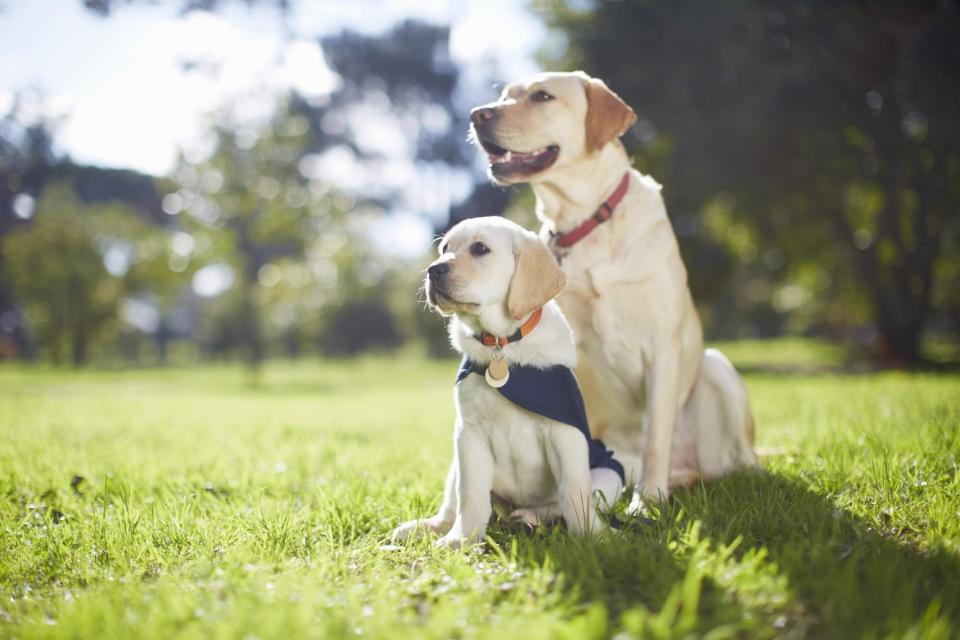How to Introduce Your New Puppy to an Older Dog
So, your family's been itching to add a new puppy to the household, and you think your older dog would love the companionship. All systems go, right? Woah, Nellie–hold on to your puppy fever for a sec. Introducing a new pup to your resident canine can be fraught with issues if you don't take the right steps to ensure everyone involved has a positive experience.
"You should introduce the two dogs slowly," says Dr. Sara Ochoa, a Texas veterinarian and vet consultant with doglab.com. "It would be best to do this on neutral territory such as a dog park or friend's house," she says.
You could also try "testing" the relationship before bringing puppy home, such as having the dogs meet at the rescue shelter, breeder, or foster parent's home to see how the dogs like one another. In fact, many shelters insist if you're bringing a new dog into a home that already has a dog or two, that they have a get-acquainted meeting upfront to suss out any personality conflicts or aggression issues.

Getty Images
How to Introduce a Puppy to an Older Dog Successfully
It would be best to have two people, one with each dog, and each dog on leash, when you make the introductions on neutral ground. "This way you can control the two dogs in case they become aggressive towards each other," says Dr. Ochoa. Allow them a few minutes to sniff each other and explore one another a bit as if it were a playdate. Then if everything seems positive between them, allow off-leash play.
One way Dr. Ochoa says to gauge if your dog is likely to welcome a puppy sibling is if he or she gets along with other dogs at the dog park.
You can get a good sense of how they'll do together by watching carefully. Then ask yourself a few important questions, and answer honestly:
Is your older dog having fun and enjoying the play session?
Are there any curmudgeonly growls, displays of aggression, or rough nipping going on?
Is the puppy being respectful of his elder, licking his face, laying on his back submitting during play?
Do both dogs seem like a match in personality, exercise needs, and play styles?
Sometimes when people bring an energetic puppy home to a senior dog, the energy levels and play styles are so vastly different that it's unfair to both dogs. A senior dog may not feel like playing much whereas a puppy is usually raring to go 24/7.
"After 20 minutes together, you can tell if they are going to get along or if you need to only give them supervised time," says Dr. Ochoa. If they need supervised time together, you can do this in increasing increments, adding five to ten minutes at each play session.
What Should You Avoid Doing When Introducing Dogs?
It's best to avoid bringing the new puppy home without meeting first on neutral territory as your resident pooch may feel intruded upon and not want to share his space, his toys, or his pet parents if the new dog is sprung on him suddenly. You should also avoid letting two dogs that seem to have issues with each other be together without supervision for a while. "I have seen this end up in a dog fight and lacerations very quickly," warns Dr. Ochoa.
What Happens If It Isn't a Match?
Just like with people, not all matches are made in heaven. So, if there is any aggression between the two dogs, it's best to have only supervised time together to see if it can resolve over time. Dr. Ochoa says it may take several months. You might also have to reconsider the new puppy or even any new dog if you suspect your dog may react negatively to any dog you bring home.
While many dogs love having a doggie sibling and can become the best of friends, some dogs simply do better in single dog households. This can be a tough call, especially when you have your heart set on a new puppy.
Making It Work Once You're Home
If the meeting is successful and the two become fast friends, it's still important take some precautions as you settle a new puppy into your home with an established dog.
Give the resident dog extra one-on-one attention and praise any time he seemingly does well with puppy.
Divide your attention between the two so no one has jealous feelings.
Take walks with both dogs together as walking is a bonding experience for dogs.
Put all the toys away for a few days and dole them out individually adding some new toys to the mix to prevent the resident dog from resource guarding his toys.
Keep feeding spaces apart for the first few weeks to ensure no one has any ill intentions about the other's food.
There's nothing sweeter than when a puppy and an older dog became fast buddies, cuddling together on their beds, playing in the yard, and looking out for each other. Introduced the right way, you too can have multi-dog bliss.

